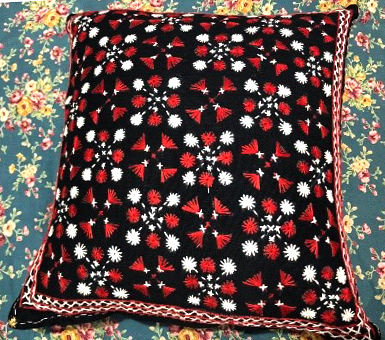การเพิ่มมูลค่าสินค้าชุมชนกะเหรี่ยง ตำบลทาเหนือ จังหวัดเชียงใหม่
Main Article Content
บทคัดย่อ
ชุมชนกะเหรี่ยง ตำบลทาเหนือ อำเภอแม่ออน จังหวัดเชียงใหม่ ต้องการยกระดับเป็นชุมชนท่องเที่ยวเชิงวัฒนธรรม แต่ผลิตภัณฑ์สินค้าที่จำหน่ายไม่มีความหลากหลายราคาขายสินค้าต่ำกว่าต้นทุนค่าแรง และการจำหน่ายสินค้าต้องผ่านผู้ค้าคนกลาง งานวิจัยนี้มีวัตถุประสงค์เพื่อพัฒนาและเพิ่มมูลค่าผลิตภัณฑ์สินค้าด้วยการวิจัยเชิงปฏิบัติการแบบมีส่วนร่วม โดยใช้กระบวนการการออกแบบความคิด ประกอบด้วย 5 ขั้นตอนได้แก่ 1) การเข้าใจเข้าถึงปัญหา 2) การบ่งชี้หรือกำหนดปัญหา 3) การคิดร่วมกันออกแบบผลิตภัณฑ์ 4) การสร้างต้นแบบ และ 5) การทดสอบด้วยการจัดการการท่องเที่ยวเพื่อเลือกซื้อสินค้าในชุมชน ผลการดำเนินงานพบว่า มีการพัฒนาผลิตภัณฑ์สินค้าชนิดใหม่ 6 ชนิด ได้แก่ เสื้อกะเหรี่ยงปักลาย ผ้าพันคอ หมอนอิง ผ้ารองจาน ผ้าปูโต๊ะ
และพวงกุญแจ และรายได้เฉลี่ยเพิ่มขึ้นร้อยละ 20 ในการพัฒนาผลิตภัณฑ์ชุมชนได้ใช้อัตลักษณ์ของเสื้อกะเหรี่ยงเป็นฐานแนวคิดในการออกแบบผลิตภัณฑ์สินค้า นอกจากนี้ เพื่อให้ชุมชนกะเหรี่ยงพัฒนาสินค้าตามที่ออกแบบได้ จึงจัดกิจกรรมฝึกอบรมการตัดเย็บ การปักผ้า การคำนวณต้นทุนและการตั้งราคาขาย นอกจากนี้ ชุมชนกะเหรี่ยงยังเป็นศูนย์กลางการทำงานรูปแบบสามประสาน ได้แก่ ภาคการศึกษา ภาคเอกชน และภาครัฐบาล และเปิดช่องทางจำหน่ายแบบออนไลน์เพื่อจำหน่ายผลิตภัณฑ์สินค้าของชุมชนกะเหรี่ยง และยังได้เชื่อมโยงผลิตภัณฑ์สินค้ากับเส้นทางท่องเที่ยวระดับชุมชนสำหรับจำหน่ายเป็นสินค้าของที่ระลึก
ซึ่งเป็นการกระจายรายได้ภายในชุมชนและส่งเสริมการสร้างเศรษฐกิจฐานรากที่เข้มแข็ง
Article Details

อนุญาตภายใต้เงื่อนไข Creative Commons Attribution-NonCommercial-NoDerivatives 4.0 International License.
Area Based Development Research Journal values copyright protection and licensing to safeguard author rights and facilitate the appropriate dissemination of research. Our policies ensure openness, accessibility, and attribution. Authors retain copyright ownership, and articles are published under a Creative Commons Attribution License (CC BY), allowing sharing, adaptation, and proper attribution. Authors have the freedom to publish under the CC BY license, granting broad reuse and distribution permissions. The journal supports posting articles on third-party repositories, adhering to institutional and funding restrictions. Author guidelines detail copyright and licensing requirements, empowering authors with knowledge about their rights and responsibilities. These policies cultivate an environment of collaboration, openness, and responsible sharing, benefiting authors and the research community while honoring intellectual property rights.
เอกสารอ้างอิง
Aaker, D. A. (1991). Managing brand equity: Capitalizing on the value of a brand name. New York: Free Press.
Achavanunthakul, S. (2020). Cost accounting. Bangkok: Chulalongkorn Press. (in Thai).
Baili, Ch. (2017). Problems and needs of textiles product in Loei province. Ratchaphruek Journal, 15(3), 88-96. (in Thai).
Berry, T., & Wilson, D. (2004). On target: The book on marketing plans. Oregon: Palo Alto Software, Inc.
Chiaralul, T. (2014). The problems and the adaption of OTOP to AEC. Executive Journal, 34(1), 177-191.
Dechakumpoo, K., & Homdee, T. (2017). Participatory mechanism of community in public area management of Had Hae, the Mekong river central island. Area Based Development Research Journal, 9(5), 347-360. (in Thai).
Government Saving Bank Research. (2020). Textile and garment manufacturing industry. Retrieved January 29, 2020, from: https://www.gsbresearch.or.th/gsb/economics/6709/. (in Thai)
Migchelbrink, K., & van de Walle, S. (2021). A systematic review of the literature on determinants of public managers’ attitudes toward public participation. Local Government Studies, In press, 1-22.
Office of the National Economic and Social Development council. (2021). Thai based economy development. Retrieved December 29, 2020, from: http://nscr.nesdb.go.th/wp-content/uploads/2019/04/16-เศรษฐกิจฐานราก.pdf/. (in Thai).
Provincial Community Development Office of Chiangmai. (2018). Chiang Mai OTOP and tourism. Retrieved December 31, 2020, from:https://chiangmai.cdd.go.th. (in Thai).
Sarsby, A. (2016). A guide to SWOT for business studies students. England: Spectaris Limited.
Stanford University. (2021). An introduction to design thinking: Process guide. Retrieved December 31, 2020, from: https://web.stanford.edu/~mshanks/MichaelShanks/files/509554.pdf.
Teeravanit, R., & Sujarinpong, P. (2009). Purchasing and using behavior hand-woven cotton as typical women’s wear. Bangkok: Kasetsart University Research and Development Institute. (in Thai).
Topanurakkun, U. (2015). A participatory action research in conserving and passing on Thai Song Dum’s cloth weaving wisdom. (Doctor’s thesis). Development Education Graduate School, Silpakorn University. (in Thai).
Yueran, S., & Waratwichit, S. (2018). Participatory action research and the success of policy change in health system. The Southern College Network Journal of Nursing and Public Health, 5(2), 291-292. (in Thai).


